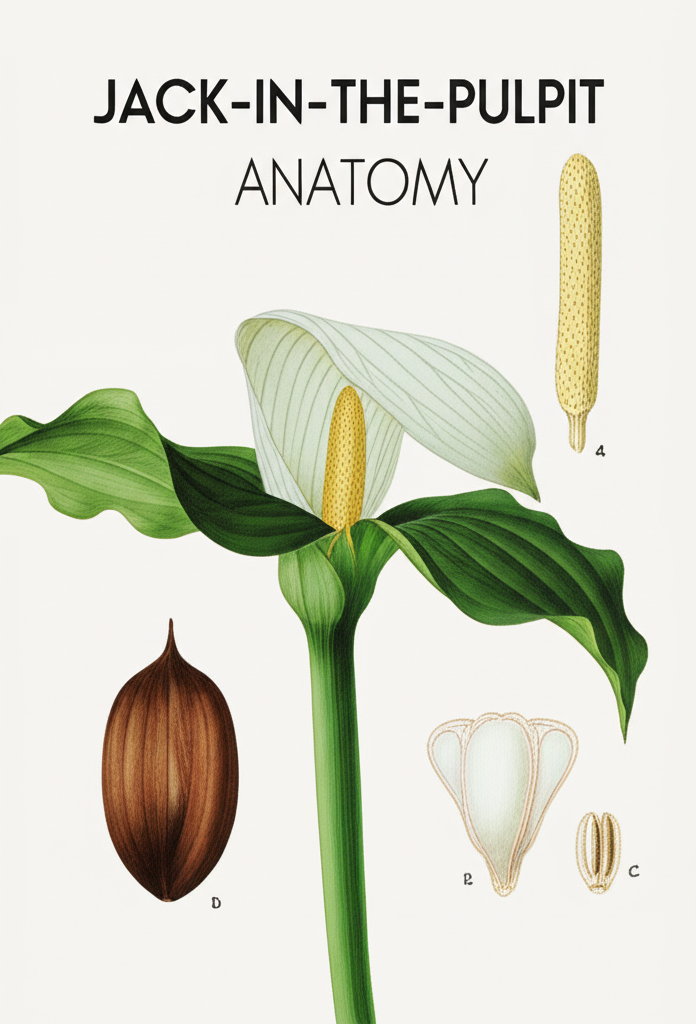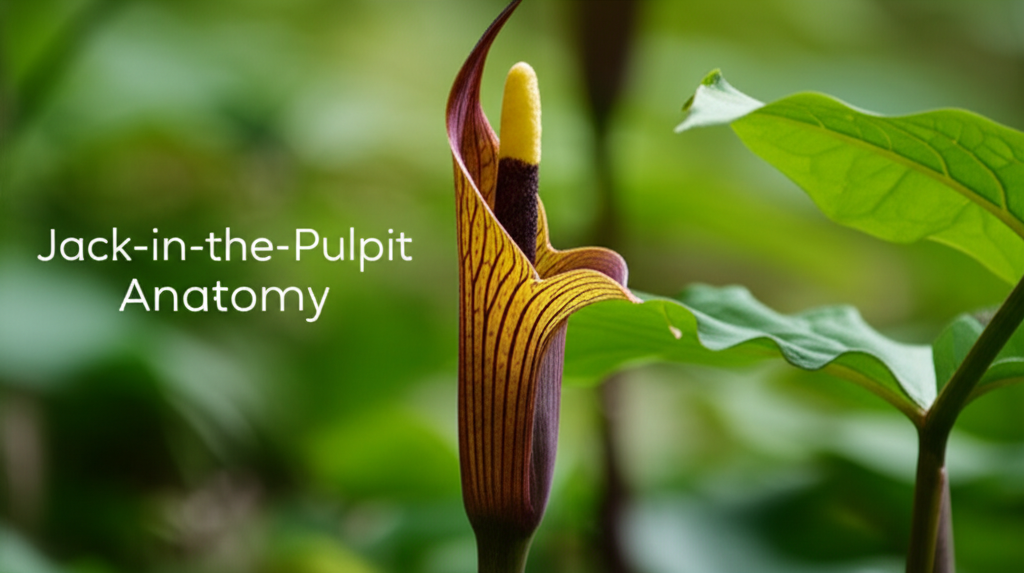Introduction to the Jack-in-the-Pulpit
The Jack-in-the-Pulpit, scientifically known as Arisaema triphyllum, is a captivating native woodland perennial that never fails to spark curiosity. Its distinctive, hooded flower structure immediately sets it apart from most other flora, making it a perennial favorite among gardeners and a subject of fascination for botany students. This plant, belonging to the Araceae family (which also includes familiar plants like calla lilies and peace lilies), possesses a complex and highly specialized floral anatomy that plays a crucial role in its survival and reproductive strategies. Understanding the intricacies of its structure is key to appreciating its ecological niche and evolutionary adaptations. This article will provide a comprehensive overview of the Jack-in-the-Pulpit’s anatomy, exploring each component in detail and highlighting its function.
The Rhizome: The Plant’s Underground Anchor

Beneath the verdant forest floor lies the true foundation of the Jack-in-the-Pulpit: its rhizome. This fleshy, horizontal underground stem is the plant’s primary storage organ and vegetative propagation center. It is typically dark brown or purplish and can grow quite large over time, often exhibiting distinct rings that mark previous years of growth.
Rhizome Characteristics and Function
The rhizome’s primary functions include:
- Storage: It stores carbohydrates and nutrients, providing the energy reserves necessary for the plant to emerge each spring and produce its distinctive flower.
- Anchorage: It firmly anchors the plant in the soil, preventing it from being dislodged by wind or water.
- Vegetative Reproduction: New plants can arise from buds on the rhizome, allowing the Jack-in-the-Pulpit to spread and form colonies.
- Calcium Oxalate Crystals: A notable characteristic of the Jack-in-the-Pulpit rhizome is the presence of calcium oxalate crystals. These needle-like crystals are irritating to the mouth and throat if ingested, serving as a deterrent to herbivores. This defense mechanism is common in the Araceae family.
The health and size of the rhizome directly influence the plant’s ability to flower and produce seeds. A robust rhizome can support the development of multiple leaves and a flower stalk.
The Leaves: Essential for Photosynthesis
The Jack-in-the-Pulpit typically presents either one or two trifoliate leaves. These leaves emerge on erect stalks called petioles, which rise directly from the rhizome. The arrangement and form of these leaves are important diagnostic features.
Leaf Structure and Role
Each leaf is compound, meaning it is divided into three leaflets (trifoliate). The leaflets are ovate to lanceolate in shape, with smooth or slightly wavy margins.
- Photosynthesis: The primary role of the leaves is to capture sunlight and convert it into energy through photosynthesis, fueling the plant’s growth and development.
- Protection: The large, spreading leaves also contribute to the shade in the understory, creating a microhabitat that can benefit other woodland plants.
- Nutrient Cycling: As leaves decompose in the fall, they return vital nutrients to the soil, enriching the forest ecosystem.
The number of leaves can vary. Younger plants or those with a less developed rhizome may have only one leaf, while mature plants can bear two. The presence of two leaves is often an indicator of reproductive maturity.
The Inflorescence: The Heart of the Jack-in-the-Pulpit’s Mystery
The most striking aspect of the Jack-in-the-Pulpit is its unique inflorescence, which consists of a spathe and a spadix. This specialized structure is designed to attract pollinators and facilitate pollination. It’s the “Jack” and the “Pulpit” that give the plant its common name.
The Spathe: The Hooded Bract
The spathe is a large, modified leaf (bract) that encloses the spadix. It is typically U-shaped or helmet-shaped, arching over the spadix. The spathe can vary in color, ranging from green to striped purple-green, or even a deep maroon.
- Protection: The spathe provides physical protection to the delicate spadix and the reproductive organs within.
- Pollinator Attraction: The spathe’s often vibrant or patterned appearance, coupled with potential scent emissions, serves to attract specific pollinators.
- Trap Mechanism: In many Arisaema species, including Jack-in-the-Pulpit, the spathe’s interior surface can be coated with downward-pointing hairs or wax, creating a slippery surface that makes it difficult for insects to climb out once they’ve entered.
The spathe’s opening, or mouth, is often recurved or reflexed, revealing the spadix within.
The Spadix: The Fleshy Spike
The spadix is a fleshy spike that bears the actual flowers. It arises from the base of the spathe and extends upwards, often emerging from the spathe’s opening. The spadix is typically club-shaped and can be green or purplish.
- Floral Bearing: The spadix is where the male and female flowers are located. These flowers are typically small and inconspicuous, lacking petals and sepals, which is common in wind-pollinated or insect-pollinated plants in the Araceae family.
- Pollinator Guidance: The spadix’s structure and potential for scent emission can help guide pollinators towards the reproductive organs.
- Sterile Appendages: At the apex of the spadix, there are often sterile, thread-like structures called staminodes. These may play a role in attracting or trapping pollinators.
The spadix’s surface is densely packed with tiny flowers, which are often difficult to discern without magnification.
Floral Organization and Sexual Dimorphism
The Jack-in-the-Pulpit exhibits a unique floral organization and, importantly, sexual dimorphism, which is a fascinating aspect of its reproductive biology. The plant can be monoecious (having both male and female flowers on the same plant) or dioecious (having separate male and female plants). More commonly, it is functionally monoecious, meaning a single plant can produce both male and female flowers, or change its sex over its lifetime.
Male Flowers
Male flowers are typically found towards the apex of the spadix. They consist of stamens, which produce pollen. These flowers are generally more numerous than female flowers and are often located above the sterile staminodes.
Female Flowers
Female flowers are located at the base of the spadix. They consist of pistils, which contain ovules that can be fertilized. Each pistil has a stigma, which receives pollen, and an ovary, which develops into a fruit.
Sexual Reversal
A remarkable characteristic of the Jack-in-the-Pulpit is its ability to undergo sexual reversal. Younger, smaller plants tend to be functionally male, producing more pollen. As the plant matures and accumulates resources in its rhizome, it can transition to being functionally female, producing more fruits and seeds. This strategy maximizes reproductive success by prioritizing resource allocation to seed production when the plant is most robust.
Pollination Mechanism: A Specialized Trap
The pollination of the Jack-in-the-Pulpit is a highly specialized process, primarily facilitated by small insects, most notably fungus gnats and other Diptera.
The Pollinator Trap
- Attraction: The spathe, with its visual cues and potential for scent production, attracts insects.
- Entry: Insects enter the spathe through its opening, seeking shelter or food.
- Trapping: Once inside, the insects are often trapped by the downward-pointing hairs or the slippery interior of the spathe.
- Pollination: As the insects crawl around on the spadix, they brush against the male flowers, picking up pollen, and then against the stigmas of the female flowers, depositing any pollen they are carrying from other plants.
- Escape: Eventually, as the spathe ages and the hairs wither or the wax dissipates, the insects can escape, carrying pollen to other Jack-in-the-Pulpit inflorescences.
This elaborate trapping mechanism ensures that pollinators spend sufficient time in contact with the reproductive parts of the flower, increasing the chances of successful pollination.
Fruit and Seed Dispersal
Following successful pollination, the female flowers develop into bright red berries. These berries are held within the persistent spathe and eventually emerge as the spathe wilts.
Berry Development
The berries are a distinctive feature of the mature plant in late summer and fall. They are typically one-seeded and contain mucilaginous pulp. While attractive, these berries are also mildly toxic due to the calcium oxalate crystals, deterring most vertebrates from consuming them in large quantities.
Seed Dispersal Agents
Despite their toxicity, the berries are dispersed by certain animals, particularly birds. Birds are less sensitive to the irritant compounds and can consume the berries, passing the seeds through their digestive system, thus aiding in dispersal. The coloration of the berries likely serves as a visual signal to these dispersers.
Key Facts and Comparison
Here’s a summary of the key anatomical features and a comparison with a more typical flowering plant to highlight the Jack-in-the-Pulpit’s uniqueness.
| Anatomical Feature | Jack-in-the-Pulpit (Arisaema triphyllum) | Typical Flowering Plant (e.g., a Rose) |
|---|---|---|
| Underground Structure | Fleshy, starchy rhizome with calcium oxalate crystals | Taproot or fibrous root system |
| Leaf Arrangement | Compound, trifoliate leaves on erect petioles | Simple or compound leaves, varied arrangements |
| Inflorescence Type | Spadix and Spathe (a specialized structure) | Raceme, panicle, spike, umbel, or solitary flowers |
| “Flower” Structure | Reduced flowers borne on a fleshy spadix, enclosed by a spathe | Petals, sepals, stamens, pistils prominently displayed |
| Sexual Reproduction | Monoecious with potential for sexual reversal; male and female flowers on the same spadix | Typically bisexual flowers (both male and female parts in one flower) or dioecious (separate male and female plants) |
| Pollination Mechanism | Insect trapping within the spathe/spadix chamber | Wind pollination, insect pollination via attraction (nectar, scent, color) |
| Fruit Type | Berry | Varies greatly (berry, capsule, drupe, achene, etc.) |
Steps in the Jack-in-the-Pulpit’s Life Cycle and Associated Anatomy
Understanding the Jack-in-the-Pulpit’s life cycle can further illuminate the roles of its anatomical parts.
| Stage/Process | Key Anatomical Components Involved | Pros of This Anatomical Feature | Cons/Considerations |
|---|---|---|---|
| Dormancy & Spring Emergence | Rhizome (stored energy) | Provides energy for rapid shoot and leaf emergence; allows survival through cold winters. | Rhizome is vulnerable to disturbance and over-harvesting. |
| Vegetative Growth | Leaves (photosynthesis), Petioles (support) | Efficient light capture for energy production; supports upright growth in shaded understory. | Leaves are susceptible to herbivores and fungal diseases. |
| Reproductive Phase (Flowering) | Spathe (attraction, protection), Spadix (flower bearing), Male/Female Flowers (reproduction) | Specialized pollination strategy increases reproductive success; sexual reversal optimizes resource allocation. | High energy cost to produce complex inflorescence; reliance on specific pollinators. |
| Pollination & Fertilization | Stigma, Ovary, Pollen | Effective trapping mechanism ensures pollen transfer; sexual dimorphism aids in resource management. | Pollination failure leads to no fruit/seed production. |
| Fruiting & Seed Dispersal | Berries (seed protection), Seeds (new generation) | Attractive to dispersers (birds); berries protect seeds. | Mild toxicity deters some dispersers; seeds require specific conditions for germination. |
| Autumn Dieback | Rhizome (storage of resources) | Nutrients are translocated back to the rhizome for the next year’s growth. | Above-ground parts are lost, leaving the plant vulnerable to surface threats. |
Conclusion: A Masterpiece of Evolutionary Adaptation
The Jack-in-the-Pulpit, with its intricate and specialized anatomy, stands as a remarkable example of evolutionary adaptation in the plant kingdom. From its robust, crystalline rhizome to its ingeniously designed spathe and spadix, every component plays a vital role in the plant’s survival, reproduction, and ecological interactions. For botany students, studying Arisaema triphyllum offers a profound understanding of concepts such as floral morphology, sexual dimorphism, pollination syndromes, and the complex interplay between plants and their environment. Its unique structure not only captivates the observer but also serves as a textbook case for exploring the diverse strategies that life employs to thrive. By delving into the anatomy of this woodland marvel, we gain a deeper appreciation for the subtle yet powerful forces that shape the natural world.


